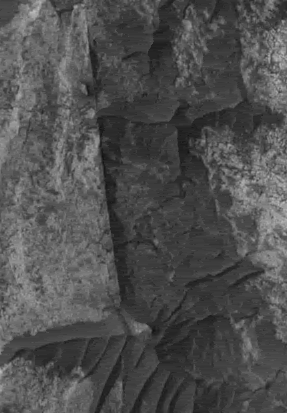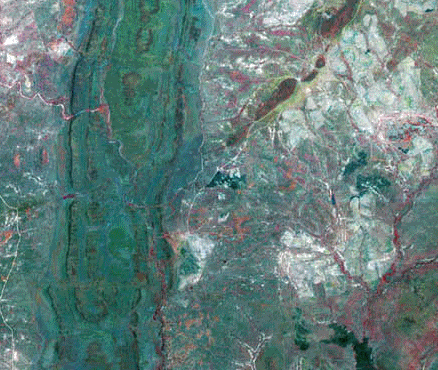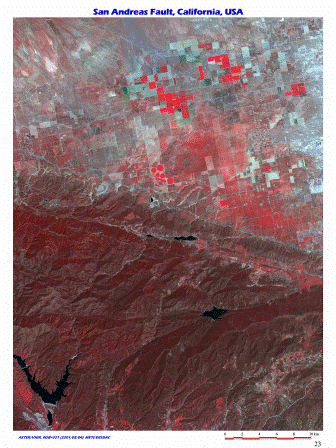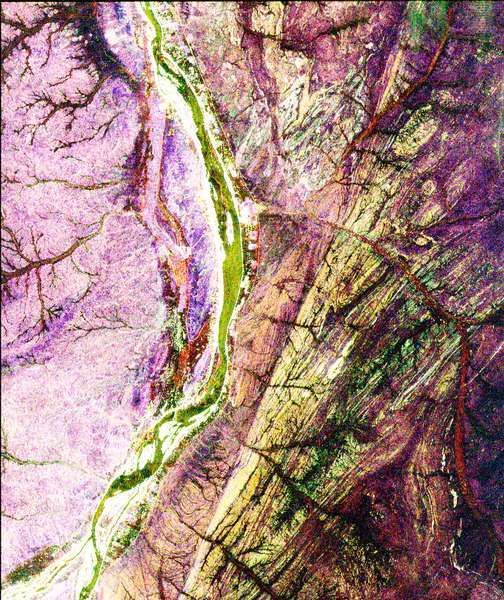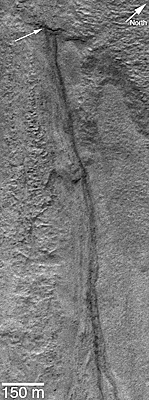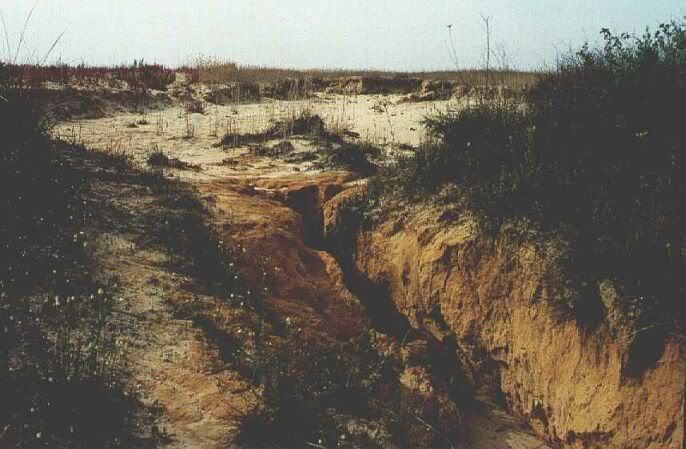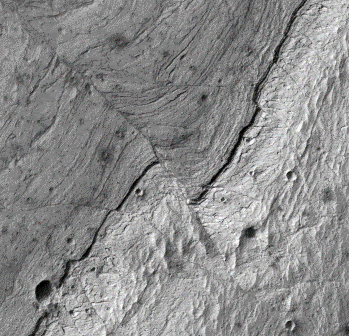- Thank you received: 0
Mro--First Looks
- neilderosa
-
- Offline
- Platinum Member
-

Less
More
18 years 2 months ago #18683
by neilderosa
Replied by neilderosa on topic Reply from Neil DeRosa
I have been claiming that because of the extreme straightness of the line that runs through this hi-res (.25 m/p) crop from Melas Chasma, it is a good candidate for artificiality, but not knowing a lot about fault lines I have to leave open the possibility that it is a natural formation.
I asked Peter Ness, a professional geologist and SPSR member for some help. Peter thinks that it is a natural fault line, and he supplied me with several images to demonstrate his contention. He also granted permission to use his information and I thank him for that. Here are compressed versions of some of the examples of fault lines of various types he relayed to me. They are from Earth, Mars, and the moon Europa.
1
2 (close up of 1)
3 (top if image is populated area)
4 Mars
5 Mars
6 the moon Europa
7 Sudan (earth)
8 Mars
earth
Mars
I could say what conclusion I drew from this, I’m almost afraid to say it’s common sense. But at least I thought I’d put it out there because it’s interesting. Here's a hint; the only one that even comes close in straightness (and uniformity) of lines is the Sudan (pink) image, and that is in very low resolution. Note the river tributaries. And I think I'm correct in assuming that the Europa image is also low resolution; correct me if I'm wrong, but even as is we can see the jaggedness of all the lines.[ ]
]
Neil
I asked Peter Ness, a professional geologist and SPSR member for some help. Peter thinks that it is a natural fault line, and he supplied me with several images to demonstrate his contention. He also granted permission to use his information and I thank him for that. Here are compressed versions of some of the examples of fault lines of various types he relayed to me. They are from Earth, Mars, and the moon Europa.
1
2 (close up of 1)
3 (top if image is populated area)
4 Mars
5 Mars
6 the moon Europa
7 Sudan (earth)
8 Mars
earth
Mars
I could say what conclusion I drew from this, I’m almost afraid to say it’s common sense. But at least I thought I’d put it out there because it’s interesting. Here's a hint; the only one that even comes close in straightness (and uniformity) of lines is the Sudan (pink) image, and that is in very low resolution. Note the river tributaries. And I think I'm correct in assuming that the Europa image is also low resolution; correct me if I'm wrong, but even as is we can see the jaggedness of all the lines.[
Neil
Please Log in or Create an account to join the conversation.
18 years 2 months ago #18869
by rderosa
Replied by rderosa on topic Reply from Richard DeRosa
Has anyone checked to see if there have been any HiRISE images anywhere near the vicinity of the "TUBES"? I spent some time looking one day, but wasn't sure about the location. I did see something that reminded me of the tubes, though.
After looking at them all in Neil's new thread, I predict that the tubes will serve to be one of the key falsifiers of the Artificiality Hypothesis. Many will have the same reaction Orme did when he saw the newer Skullface.
rd
After looking at them all in Neil's new thread, I predict that the tubes will serve to be one of the key falsifiers of the Artificiality Hypothesis. Many will have the same reaction Orme did when he saw the newer Skullface.
rd
Please Log in or Create an account to join the conversation.
18 years 2 months ago #18785
by Trinket
Replied by Trinket on topic Reply from Bob
hiroc.lpl.arizona.edu/images/PSP/PSP_001..._1410_RED.browse.jpg
There is art .. scale.... tubes ?.. I dont think so..
There is art .. scale.... tubes ?.. I dont think so..
Please Log in or Create an account to join the conversation.
- tvanflandern
-
- Offline
- Platinum Member
-

Less
More
- Thank you received: 0
18 years 2 months ago #19414
by tvanflandern
Replied by tvanflandern on topic Reply from Tom Van Flandern
<blockquote id="quote"><font size="2" face="Verdana, Arial, Helvetica" id="quote">quote:<hr height="1" noshade id="quote"><i>Originally posted by Trinket</i>
<br />There is art .. scale.... tubes ?.. I dont think so..<hr height="1" noshade id="quote"></blockquote id="quote"></font id="quote">Those are collapsed tubes. After you've seen dozens of examples, the difference is easy to spot. For one thing, the collapsed tubes have twice the frequency of wide bands per unit of tube length, as compared with intact tubes.
I've been watching for MRO images of intact tubes, but none have been released yet. I suspect they won't be anytime soon. It's too likely to be a "smoking gun". -|Tom|-
<br />There is art .. scale.... tubes ?.. I dont think so..<hr height="1" noshade id="quote"></blockquote id="quote"></font id="quote">Those are collapsed tubes. After you've seen dozens of examples, the difference is easy to spot. For one thing, the collapsed tubes have twice the frequency of wide bands per unit of tube length, as compared with intact tubes.
I've been watching for MRO images of intact tubes, but none have been released yet. I suspect they won't be anytime soon. It's too likely to be a "smoking gun". -|Tom|-
Please Log in or Create an account to join the conversation.
18 years 2 months ago #18821
by rderosa
Replied by rderosa on topic Reply from Richard DeRosa
I have never seen this before, and all the negatives about JPL notwithstanding, I'd have to say this sounds like a fairly honest objection:
<blockquote id="quote"><font size="2" face="Verdana, Arial, Helvetica" id="quote">quote:<hr height="1" noshade id="quote">JPL Scientist's Explanation
Of The 'Tubes' On Mars
From Robert Collins
rcollins632@earthlink.net
3-10-01
Subject: More handwaving?
Date: 3-9-01
From: Dave Pieri
To: rcollins
Dear Robert
This is a professional interpretation based on having labored over literally thousands of Viking Mars Orbiter Images, hundreds of Mars Observer images, many, many, many Landsat, ASTER, and airphotos of the earth, having studied aeolian and fluvial geomorphology at the graduate level at two universities, and well over 20 years of aerial and orbital photointerpretation and optical and radar remote sensing here at JPL/Caltech--and years of field experience in a range of climatic zones from desert to arctic. Also, the subject of my Ph.D. thesis was (the first) systematic global study of martian valley networks, in which I looked at thousands of features, such as the one in the MGS image, over a period of years.
mars.jpl.nasa.gov/mgs/
Realize one critical fact--these are not "tubes"...the positive relief is an ILLUSION--the area is crossed by concave valleys. The transverse dune trains are emplaced on the valley floors--this is not new, either or Mars or the Earth. It even occurred at very small scale in the Viking Lander 1 site in Chryse Planitia...not all that far away from where this MGS picture was taken.
Look carefully at how the craters in the larger reference image are lit. Then look at the valley wall shadows. Seeing inverted relief is an easy mistake to make, even by an experienced photointerpreter--at first glance. That's why it's always important to check one's first impression against obvious features in the landscape to get oriented properly.
Also, the picture on the "Enterprise" web site is hopeless.
www.enterprisemission.com/images/arthur.jpg
Way overstretched, saturated, and doesn't show other relevant parts of the scene. I downloaded the original data at full resolution from Mike Malin's web site in La Jolla, then used a square-root stretch to even out the contrast. It's clear that these crescentic dune-lets populate the landscape--and occur in all the low troughs or valleys throughout the image (take a look at the subscene attachment). They are a variety of sief and nearly barchan dunes--dead ringer analogs to those in terrestrial deserts. Turn the image 180 degrees (vs. the "Enterprise" picture) so that valleys look like valleys and craters look like craters, not bumps. The 3D striated "glass worm" illusion vanishes, and we're left with a fairly mundane image, exciting only to those of us who have studied the morphology of the valley networks on Mars.
Dunes follow aerodynamic principles--therefore they DO often line up in really precise, repetitive ways related to aero/hydrodynamic streamlines and standing wave resonances.
****** David C. Pieri, Ph.D. Earth and Space Sciences Division Mail Stop 183-501 Jet Propulsion Laboratory 4800 Oak Grove Drive Pasadena, CA 91109 USA FAX: 818-354-0966 VOICE: 818-354-6299 dave@lithos.jpl.nasa.gov dave@aster2.jpl.nasa.gov
rd
<blockquote id="quote"><font size="2" face="Verdana, Arial, Helvetica" id="quote">quote:<hr height="1" noshade id="quote">JPL Scientist's Explanation
Of The 'Tubes' On Mars
From Robert Collins
rcollins632@earthlink.net
3-10-01
Subject: More handwaving?
Date: 3-9-01
From: Dave Pieri
To: rcollins
Dear Robert
This is a professional interpretation based on having labored over literally thousands of Viking Mars Orbiter Images, hundreds of Mars Observer images, many, many, many Landsat, ASTER, and airphotos of the earth, having studied aeolian and fluvial geomorphology at the graduate level at two universities, and well over 20 years of aerial and orbital photointerpretation and optical and radar remote sensing here at JPL/Caltech--and years of field experience in a range of climatic zones from desert to arctic. Also, the subject of my Ph.D. thesis was (the first) systematic global study of martian valley networks, in which I looked at thousands of features, such as the one in the MGS image, over a period of years.
mars.jpl.nasa.gov/mgs/
Realize one critical fact--these are not "tubes"...the positive relief is an ILLUSION--the area is crossed by concave valleys. The transverse dune trains are emplaced on the valley floors--this is not new, either or Mars or the Earth. It even occurred at very small scale in the Viking Lander 1 site in Chryse Planitia...not all that far away from where this MGS picture was taken.
Look carefully at how the craters in the larger reference image are lit. Then look at the valley wall shadows. Seeing inverted relief is an easy mistake to make, even by an experienced photointerpreter--at first glance. That's why it's always important to check one's first impression against obvious features in the landscape to get oriented properly.
Also, the picture on the "Enterprise" web site is hopeless.
www.enterprisemission.com/images/arthur.jpg
Way overstretched, saturated, and doesn't show other relevant parts of the scene. I downloaded the original data at full resolution from Mike Malin's web site in La Jolla, then used a square-root stretch to even out the contrast. It's clear that these crescentic dune-lets populate the landscape--and occur in all the low troughs or valleys throughout the image (take a look at the subscene attachment). They are a variety of sief and nearly barchan dunes--dead ringer analogs to those in terrestrial deserts. Turn the image 180 degrees (vs. the "Enterprise" picture) so that valleys look like valleys and craters look like craters, not bumps. The 3D striated "glass worm" illusion vanishes, and we're left with a fairly mundane image, exciting only to those of us who have studied the morphology of the valley networks on Mars.
Dunes follow aerodynamic principles--therefore they DO often line up in really precise, repetitive ways related to aero/hydrodynamic streamlines and standing wave resonances.
****** David C. Pieri, Ph.D. Earth and Space Sciences Division Mail Stop 183-501 Jet Propulsion Laboratory 4800 Oak Grove Drive Pasadena, CA 91109 USA FAX: 818-354-0966 VOICE: 818-354-6299 dave@lithos.jpl.nasa.gov dave@aster2.jpl.nasa.gov
rd
Please Log in or Create an account to join the conversation.
18 years 2 months ago #18788
by rderosa
Replied by rderosa on topic Reply from Richard DeRosa
On the other hand, the tubes could be "leavings" from giant Martian worms. Seriously, I don't know who wrote this, but he makes a cogent argument.
ebtx.com/mars/marstube.htm
rd
ebtx.com/mars/marstube.htm
rd
Please Log in or Create an account to join the conversation.
Time to create page: 0.361 seconds

